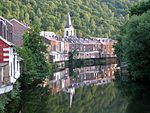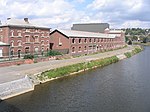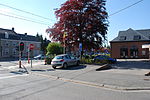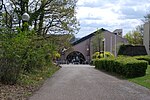Fort d'Embourg
Brialmont fortsChaudfontaineFortified position of LiègeGovernment buildings completed in 1884Infrastructure completed in 1884 ... and 3 more
Museums in Liège ProvinceWorld War II museums in BelgiumWorld War I museums in Belgium

The Fort d'Embourg is one of twelve forts built around Liège, Belgium, in the late 19th century. The overall Fortified Position of Liège was a constituent part of the country's National Redoubt. Fort d'Embourg was built between 1881 and 1884 according to the plans of General Henri Alexis Brialmont. Contrasting with the French forts built in the same era by Raymond Adolphe Séré de Rivières, the fort was built exclusively of unreinforced concrete, a new material, rather than masonry. The fort was heavily bombarded by German artillery in the Battle of Liège in World War I and again at the opening of World War II. It has been preserved and is operated as a museum.
Excerpt from the Wikipedia article Fort d'Embourg (License: CC BY-SA 3.0, Authors, Images).Fort d'Embourg
Voie de l'Ardenne,
Geographical coordinates (GPS) Address Nearby Places Show on map
Geographical coordinates (GPS)
| Latitude | Longitude |
|---|---|
| N 50.581861111111 ° | E 5.6180555555556 ° |
Address
Fort d'Embourg
Voie de l'Ardenne
4053
Liège, Belgium
Open on Google Maps











